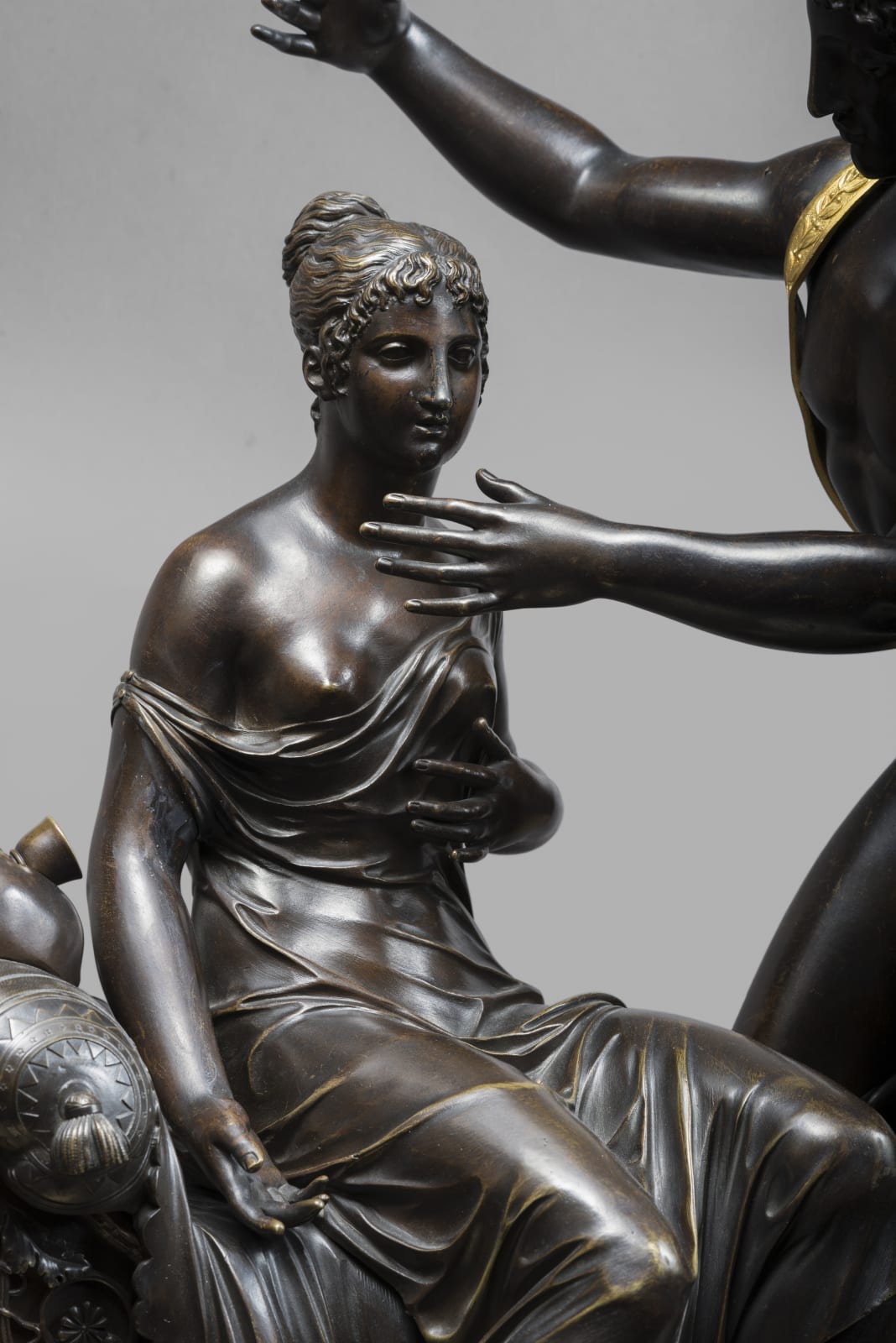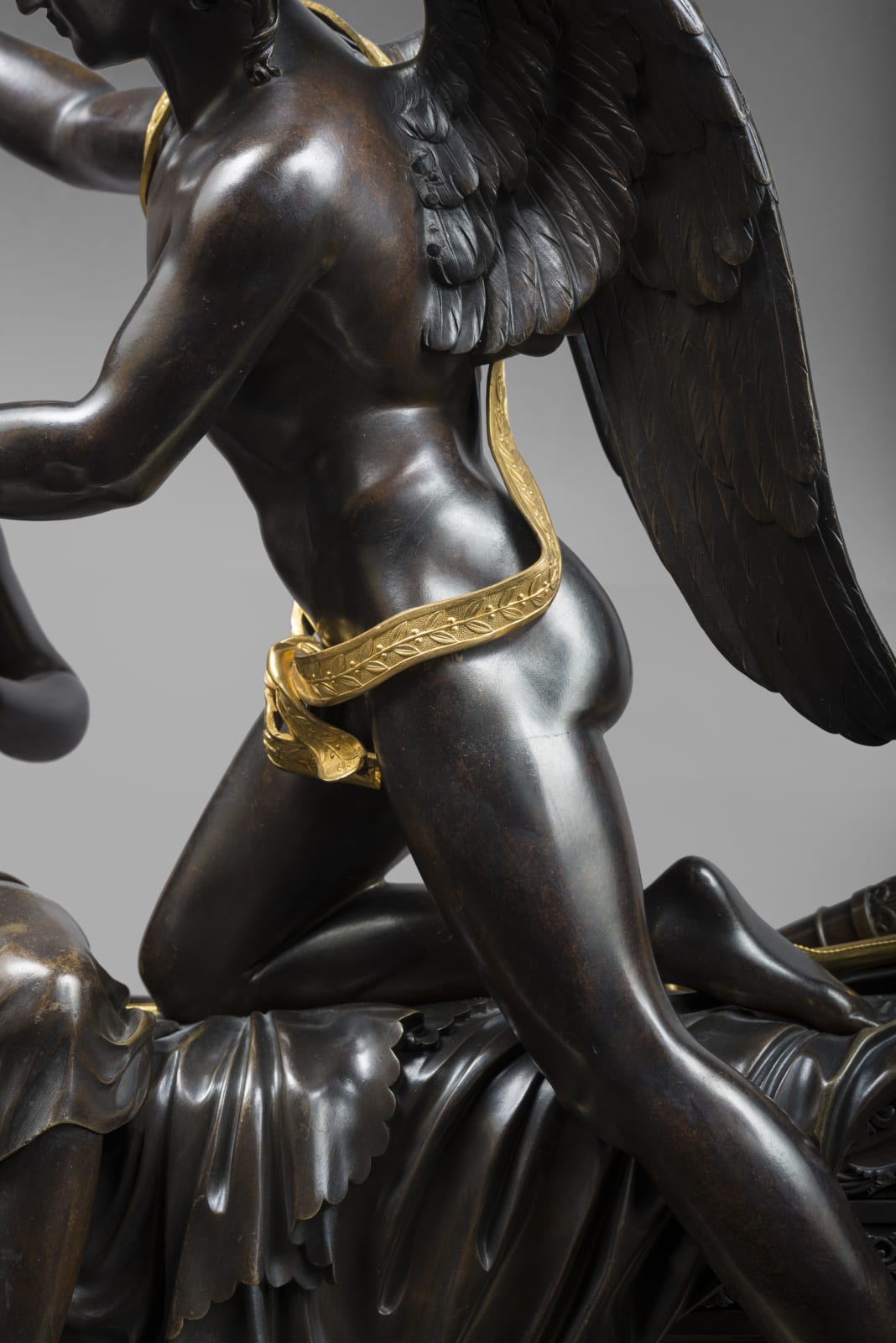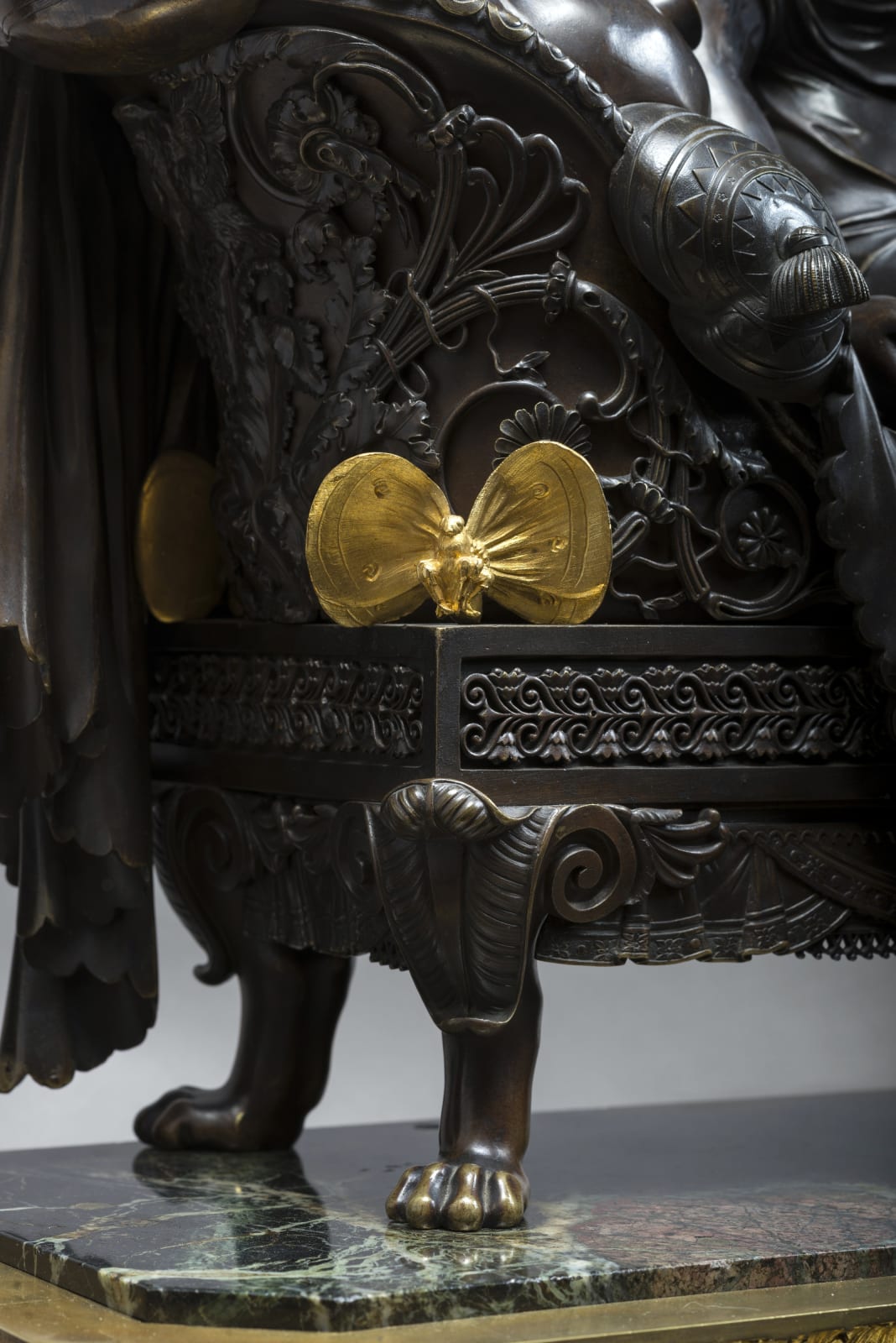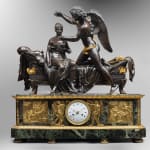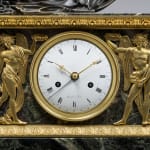Pierre-Philippe Thomire (attributed to) French, 1731-1843
Further images
Literature
Hans Ottomeyer and Peter Pröschel, "Vergoldete Bronzen", 1986, p.321, pi. 5e, illustrating a similar clock with case by Thomire of 1799 in the Hermitage, Leningrad. / Ramon Colon De Carvajal, "Catalogo De Relojes Del Patrimonio Nacional", 1987, p. 125, illustrating a clock by Raguet-Lepine in the Spanish Royal Collection, Madrid, with similar figures of Cupid and Psyche with dial above.
An extremely rare and very important Empire patinated and gilt bronze and marble clock of eight day duration, signed on the white enamel dial Mesnil a Paris, with an exquisite bronze case depicting the story of Cupid and Psyche attributed to the pre-eminent bronzier, Pierre-Philippe Thomire (1751-1843). The dial with a centre ring showing minute intervals, an inner ring with Roman numerals for the hours and outer ring with Arabic numerals 1-30 (in accordance with the Republican 30 day month). Having a fine pair of pierced gilt brass hands and a blued steel hand to indicate the days of the month. With bell striking movement. The clock set into a rare and expensive marble base, surmounted by the magnificent figures of Cupid and Psyche upon a couch ornamented at each end by a butterfly, with Cupid's quiver full of arrows resting on the couch. The dial set between two figures of Cupid, each holding triumphal wreaths and a flaming torch, symbolising the fire of love. With four finely chased gilt bronze plaques on the sides and front of the base illustrating scenes from the story of Cupid and Psyche.
Paris, date circa 1800
Height 86 cm, width 85 cm, depth 29 cm.
This is undoubtedly one of the most important clocks of the Empire period. The quality of the bronze case closely compares with examples in the Hermitage and Spanish Royal Collection. The story of Cupid and Psyche was told by Lucius Apuleius in the 'Golden Ass', 2nd century A.D. Venus was so jealous of Psyche's beauty that she sent her son Cupid to persecute her but instead he fell passionately in love. The story is continued on the plaque on the left side of the clock (unseen in this illustration); it shows Cupid carrying Psyche in his arms as he flies toward his palace. There he visited her when it was dark so that she could not see who he was. However her jealous sisters persuaded Psyche that Cupid was monstrous and should be killed. The story is continued of the front right plaque: encouraged by her sisters, Psyche approached the sleeping Cupid with dagger in hand. She also took a lamp so that she could see who he was but accidentally hot oil from the lamp dropped onto him and he awoke.
The front left plaque shows Cupid trying to escape while Psyche (who now realised how beautiful he was) clings onto his robes; the lamp has fallen onto the ground. The last panel, on the right hand side (again out of view) shows Cupid flying away, with Psyche clinging on with one hand and still holding the dagger in the other. Apuleius s story continued to describe how Psyche relentlessly searched for her lover and had to accomplish endless tasks set by Venus, which Cupid secretly helped her with. Jupiter finally took pity on her; Mercury carried her to heaven where she finally married Cupid. Psyche appeared in late Greek literature as a personification of the soul, purified by suffering to enjoy true love. Earlier representations of the soul (especially on Greek sarcophagi) showed a butterfly emerging from a chrysalis, which would presumably explain the presence of the butterflies at either end of the couch. The movement for the clock was made by the firm of Mesnil à Paris, established at Charnier des Innocents by 1806 and at Rue Neuve Saint-Marc from 1812-15. Mesnil supplied other clocks to Thomire and also to the bronzier, Andre-Antoine Ravrio; notably one made for Josephine for the Palais de l'Elysee. Other examples by Mesnil can be seen at the Kunsthandel, Munich, the Stedelijk Museum, Leiden and at Stockholm Castle.
Pierre-Philippe Thomire was the greatest craftsman of his age to work in gilt bronze. He was patronised by Louis XVI, Napoleon and Louis XVIII as well as foreign monarchy and aristocracy. Born in Paris, he began his training under the sculptors J-A. Houdon and A. Pajou at the Academic St. Luc, Paris and then followed his fathers profession as a fondeur-ciseleur. He studied under the great fondeur-doreur, Pierre Gouthiere (1732-1813/14), from whom he acquired the most refined skills in chasing and gilding, in particular matt gilding 'dorure au matt', to produce a subtle grainy satin-like finish. Appointed a maitre-fondeur in 1772, he set up his own business in 1776 following the collaboration with J-L. Prieur in the decoration of the coronation coach for Louis XVI. Other royal commissions followed, for instance he supplied gilt bronze chenets with flaming urns and sphinxes for the Louvre in 1786. In 1788 he supplied a fine fire grate and pair of columns to an English gentleman, purchased in 1987 by the Victoria and Albert Museum, London. He was also appointed modeller to the Royal Sèvres porcelain factory in 1783.
During the Revolution, Thomire prudently turned to manufacture of arms and ammunition but returned to decorative bronzes after the Consulate and was soon employing about 800 men. His pre-Revolutionary success was subsequently overshadowed by his fame during the Empire, when he supplied substantial commissions to the Imperial court and was appointed ciceleur de 1'Empereur in 1809. His art proved to be some of the purest and finest expression of the Empire style (promoted by Percier and Fontaine) such as his Vase de Marriage de 1'Empereur (Versailles). He also created other monumental Greek shaped urns, which were delicately modelled with crisp foliage and figures in low relief as well as magnificent centre-pieces or candelabra supported by winged Victories. In 1811 Thomire collaborated with imperial goldsmith, J-B-C. Odiot to make the cradle for the King of Rome after a design by P-P. Prud'hon (Schatzkammer, Vienna). He also worked the bronze for another Imperial cradle (Fontainebleau).
Thomire engaged in a number of important collaborations; this was as much due to the unparalleled quality of his castings as well as the pre-Revolutionary guild restrictions upon all craftsmen such as furniture, porcelain and clockmakers. For instance he provided a number of fine gilt bronze mounts to the leading ebenistes, such as G. Benneman, F. Schwerdfeger and particularly to A. Weisweiler. He also supplied mounts for Sevres porcelain clock cases to house movements by the finest Parisian clockmakers, such as one by Robert Robin, 1788 (in the Musée des Arts Decoratifs, Paris).
After the Revolution, Thomire produced a number of figural clock cases directly inspired by famous Neoclassical sculptures or paintings. Two famous examples in the British Royal Collection are his 'Oath of Horatii' and 'Rape of the Sabine Clock'; both adapted from paintings by the leading Neo-classical master, J-L. David. At other times Thomire featured Greek heroes such as the Apollo Clock' or others showing Father Time, who carries a clock upon his shoulder (examples of both were purchased by King George IV). The 'Psyche and Cupid Clock' is one of his most beautiful and rarest works, known examples can be found at the Hermitage, Leningrad, the Spanish Royal Collection, Madrid and presently on show at the Richard Redding Gallery. After the Restoration, Thomire enjoyed the patronage of the Bourbons and in 1834 was awarded the Legion d'Honneur by Louis Philippe. He retired in ; 1823 but continued to make occasional sculptures. His firm Thomire et Cie. was continued by his two sons.


